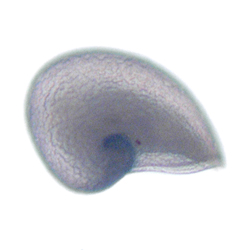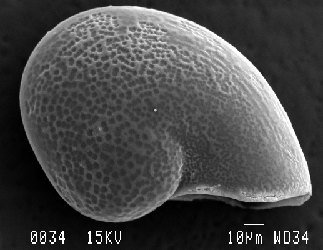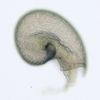

| Size under dissecting microscope: 160µm Size under compound microscope: 155-160µm |
| Morphology: These are small protoconchs with dense, shallow pitted sculpture over the entire shell, forming lines on the outer distal face. The shell itself is rather angular in overall appearance, with portions of the outline appearing almost flat. The aperture is slightly sinuous, with a narrow rim visible under the light microscope. The protoconch resembles Sutilizona theca, a slit limpet described from 13°N EPR in McLean 1989 (SEM Fig. 4F). |
| Frequency: Pump EPR 1999-2000: Frequent Pump EPR 2004: Frequent Trap EPR 2004-2005: Frequent |
Clypeosectus delectus. “Pointy apex” is very similar in size and appearance to that of Clypeosectus delectus. It is possible that both protoconchs represent different forms of the same species (or possibly two species in the same genus), but because of consistent differences in their morphology, we have kept them separate for the present. They can be distinguished by the more angular shape of this species, by its slightly smaller size (160μm vs. 175μm for Clypeosectus) and by its narrower aperture rim. The photo on the bottom shows pointy apex on the left, Clypeosectus delectus on the right. |
|
Lepetodrilus spp. Lepetodrilus spp. have finer pitted sculpture that doesn't usually show lineation. The base of the shell lines up with the aperture in these protoconchs, whereas in pointy apex it protrudes below. Pointy apex is about 15-20µm smaller. |
|
 |
Gorgoleptis spp., especially G. spiralis, pictured at left. All Gorgoleptis species have a sharp point at the outer edge of the aperture and two have points at the sides as well. Gorgoleptis spiralis is slightly smaller than pointy apex; the other two species are about 20µm larger. |
Go to:
Home
Gastropods by Size
Gastropods by Species
Other Taxa